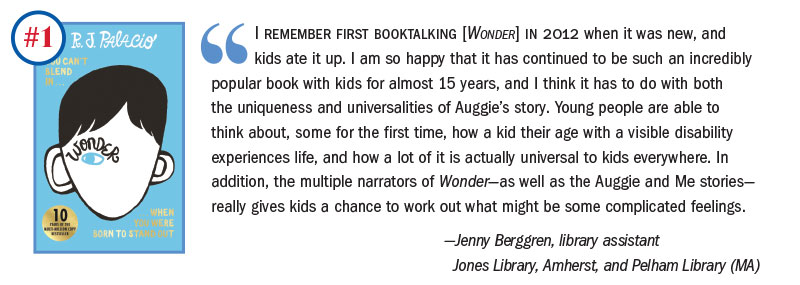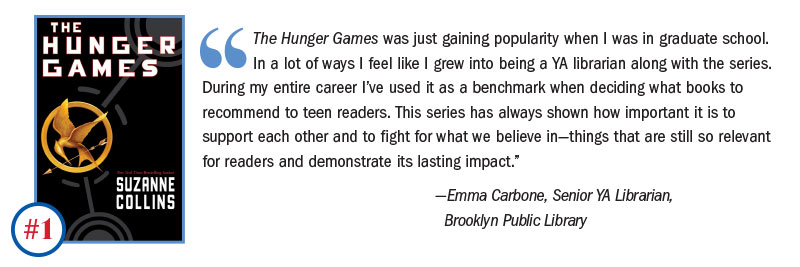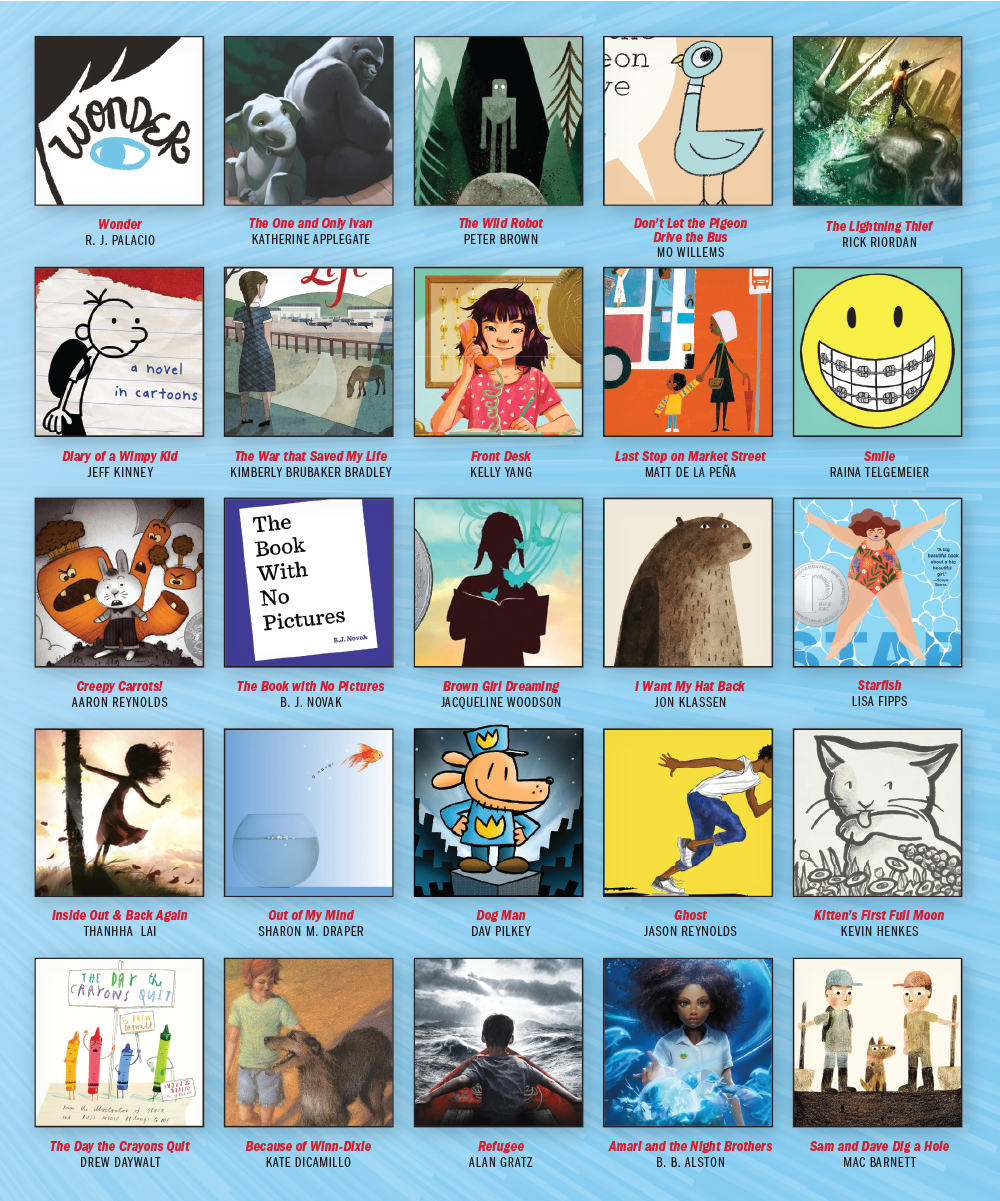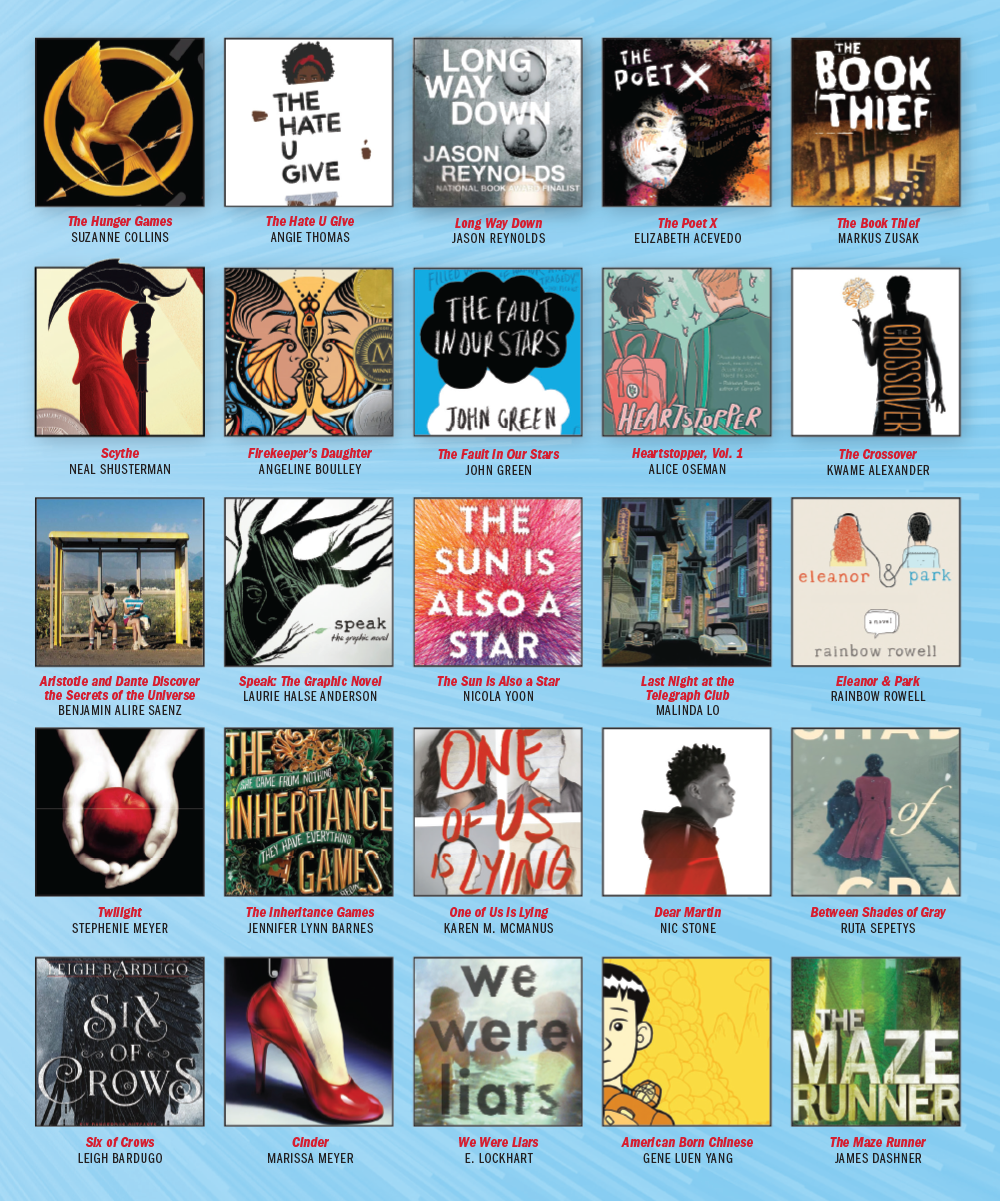Readers' Survey: 21st Century Canon
From Wonder to The Hunger Games, readers pick the most influential books of the last 25 years.
READERS’ SURVEY | MOST INFLUENTIAL BOOKS | 2000–2025
The 21st century has brought children’s literature more diversity and a willingness to explore difficult and complex topics. In addition, in the last five years, the publishing world—and the young readers it serves—have dealt with a global pandemic and a new, orchestrated censorship campaign seeking to remove books, particularly those that include the LGBTQIA+ community or discuss race and identity.
Through it all, children’s authors and illustrators have created titles that teach empathy, reflect the lives of the most marginalized, and share everyone’s story. They have created books that change and save lives, along with those that entertain, connect, and create lifelong readers. And we wanted to know what our readers thought were the most influential titles of the last 25 years.
Children’s BooksThe 25 most influential titles for ages 0-12
|

“When we first started developing this survey, our primary goal was to provide a fun and happy-making exercise that could be a bright spot amid the dark times impacting our profession,” says SLJ reviews director Shelley Diaz. “We hope this has provided a joy-filled respite.”
We asked for the most influential books of the last 25 years in two age categories: 0–12 and 12–18. Apologies to the many respondents who wished the question created separate lists for age groups or genres, picture books, middle grade, graphic novels, etc. But we wanted the books that stood out against all others—not just ones like them.
In all, 1,638 individual titles were named for ages 0–12 and 1,657 for 12–18. We’ve pulled the top 25 for each category.
“These selections are a blend of titles that have left an indelible mark on my own reading life and on how I recommend books for kids and teens, including books that changed my brain, books that showed the world I want for the kids and teens I work with, and books that show what just a little representation, a little kindness, and a little imagination for something better can really do,” said Emma Carbone, senior YA librarian at Brooklyn Public Library.
For many respondents, the effort was a trip down memory lane.
“Over the last 25 years, I’ve worked in public and school libraries in three states and have also become a parent to two kids, so thinking through the best in kids’ and YA books of that time period was a fascinating trip into my own history of reading and recommending books to young people,” said Jenny Berggren, library assistant at Jones Library, Amherst, and Pelham Library, both in Massachusetts. “I am thrilled that the field has become so much more diverse during the last 25 years and sickened about the backlash of book banning over the last few. I guess it just underscores how incredibly important and essential authors, illustrators, publishers, and librarians are in the lives of our young people, and our future as a whole.”
The numbers back up Berggren’s assessment that the selections have diversified.
Young Adult BooksThe 25 most influential titles for ages 12-18
|

The Cooperative Children’s Book Center (CCBC) has tracked diversity in children’s literature since 1985. In 2000, the CCBC reviewed more than 5,000 books and found approximately 10 percent were by or about BIPOC communities. In 2024, it assessed 3,619 books for children and teens and, for the first time, more than half (51 percent) of the titles had “significant BIPOC content—meaning they have a primary or significant secondary character or human subject who is BIPOC, or the setting or topic of the book relates to BIPOC people, history, or culture.” The report said representation of Black (16 percent), Asian (13 percent), and Indigenous (3 percent) people all grew compared to 2023.
In recent years, the CCBC has also seen more books with characters that are multiracial/multiethnic; that reveal intersectional identities; or are from the disability, LGBTQIA+, or non-Christian communities. Among the books reviewed in 2024, 7 percent featured a primary or significant secondary character with a disability and 7 percent included LGBTQIA+ themes or characters—both unchanged from 2023. However, 6 percent included content related to a minority religion, which is up from 4 percent the previous year.
Readers’ choices reflected this increased diversity, including seven of the top 10 titles on the ages 12–18 list having BIPOC or LGBTQIA+ representation or creators. The top book in 0–12, Wonder, centers around a child with a disability. Adding to the popularity and offering an avenue into the books for new readers, more than half of the 50 titles have been adapted for film, television, or theater.
“My choices are based entirely on quality of story and the ways I’ve seen it resonate with readers,” said Margaret Thomas of Stillwater, MN. “Too often lists like these get generated by what’s already on the [New York Times] Best Sellers List. I’m truly grateful that SLJ is creating this list, because it’s too easy for adults to default to what they read as a kid. By forcing people to choose titles from the [last] 25 years, my hope is that the results will elevate some titles that need to stay or resurface to more readers’ attention.”
Respondents weighed student popularity more than their own opinion, with one noting that she doesn’t love the “Diary of a Wimpy Kid” series but can’t ignore its huge impact in creating young readers.
Another librarian wrote, “All of these are books that are loved by readers over the years—ones that I had to have multiple copies.”
One high school librarian went to the data.
“I started by thinking about the titles that have been the most popular in our high school library, then looked at our statistics over the past 25 years,” they wrote. “It was hard to narrow it down to just 25, but I think this is a fairly good reflection of what students at our school have been reading the most on their own.”
Editor PicksSLJ’s reviews editors offer their own curated shortlists of standout titles from the past 25 years Latine GemsThe We Need Diverse Books movement impacted children’s book publishing in such a monumental way. Underrepresented stories and experiences were given a space that was long overdue. Latine readers, like me, were finally able to see themselves in books. And Latine creators received the recognition that they deserve. Merci Suárez Changes Gears by Meg Medina • Out of Darkness by Ashley Hope Pérez • The Last Cuentista by Donna Barba Higuera • More Happy Than Not by Adam Silvera • The Poet X by Elizabeth Acevedo
Fandom SeriesThe idea of “fandom” as we know it today really sprung to life with Harry Potter and Twilight. Harry Potter was first published in the late 90s so it wouldn’t make this list, but all of these big YA series started post-Twilight, with their first books falling in the past 25 years.
Twilight by Stephenie Meyer • City of Bones by Cassandra Clare (first “Shadowhunters” book) • The Hunger Games by Suzanne Collins • Shadow and Bone by Leigh Bardugo • Throne of Glass by Sarah J. Maas StandoutsJacqueline Woodson and Gideon Sterer have careeningly different takes on playtime, both bullseyes, while Drew Beckmeyer and Antwan Eady know that for nonfiction to hit, it has to be a story. Angharad Walker wrote the most gripping book of this century, across genres and age ranges.
The World Belonged to Us by Jacqueline Woodson, illus. by Leo Espinosa • The Last Stand by Antwan Eady, illus. by Jerome Pumphrey and Jarrett Pumphrey • I Am a Tornado by Drew Beckmeyer • From Ed’s to Ned’s by Gideon Sterer, illus. by Lucy Ruth Cummins • The Ash House by Angharad Walker |
RELATED
The job outlook in 2030: Librarians will be in demand
The job outlook in 2030: Librarians will be in demand
ALREADY A SUBSCRIBER? LOG IN
We are currently offering this content for free. Sign up now to activate your personal profile, where you can save articles for future viewing











Add Comment :-
Be the first reader to comment.
Comment Policy:
Comment should not be empty !!!